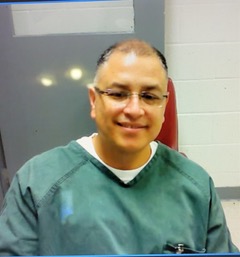
Here are the facts and a summary of the case evidence in the case for Mario Chavez and his innocence.
1. As we know, The Sixth Amendment states that a person accused of a crime has the right to confront a witness against him or her in a criminal action. Mario Chavez was denied his constitutional rights to a fair trial – Denied his right to confront his accuser in court.
1.5 The state’s theory is that Mario lured the victim to the house to kill him. But this theory doesn’t check out with the reality of the facts.
(A) The victim was called from a pay phone to be lured. But the evidence showed it highly improbable that Mario could have made the call due to a digital alibi and foot print that has him at another location at the approximate time of the call.
(B) The evidence shows that Mario received a call from Eloy and then went to view the house for legitimate reasons. But according to the neighbors his behavior while at the house was not the behavior of someone who was about to murder someone. According to neighbor statements, Mario toured the property, greeted the neighbors, and in no way tried to hide his presence there.
(C) Eloy, by his own admission, was also present at the scene, but goes undetected. And also by his own admission was at the very location of the pay phone call that lured the victim to his death at the approximate time of the call.
2. Eloy gave multiple testimonial statements to police. In those statements his story constantly shifted. The police learned that he lied on multiple counts. They learned, for instance, that he had possession of the murder weapon both before and after the crime, and according to his statements he disposed of the weapon.
3. Eloy stated that he never went near the body, but there was a size 9 foot print in the victims blood. Mario wears a size 12. Eloy wears a size 9, and the police ignored this
4. To prove motive Eloy told police that he had seen Mario with a book titled, “how to be a hit man” a theory that police latched onto only to later learn that that book along with others like it had been downloaded on Eloy’s home desktop computer a year before Mario ever arrived in New Mexico.
5. There is a huge issue of where the victims wallet was found, it was discovered in the mens locker room of a jewish community center in Tucson Arizona. There were only 11 people signed into that locker room. One of them was Dennis Melin, Mario’s ex-father-in-law and ex business partner, And Mario had been receiving open threats via phone and email from him where he demanded that Mario pay him high six figure sums in compensation for his losses. People were aware of these emails, aware of the threats being made by Dennis and other business partners and simply chose not to investigate. Police found no evidence to suggest that Mario gave the wallet to Dennis or sent it to him.
6. Mario came to New Mexico because he was receiving threats on his life in Arizona. Mario was openly looking at properties as investments. He was in the process of moving to New York City with his wife and daughter and nothing of this crime makes sense to anything that Mario was doing. Eloy on the other hand openly lied to the police and had both motive and opportunity.
7. His trial lawyer did not do much to help, spending only $50 in investigation efforts to the case.
If you want to contribute to Bring and End to the Governmental Misconduct that Leads to Wrongful Convictions, please visit this link to sign my petition.
Here is the ongoing list of legal documents for the case of Mario Chavez in New Mexico.
(Tenth Circuit 8/14/2023)
